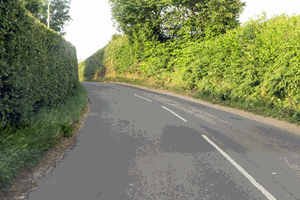
The image shows that you are driving on a road without a pavement and no central road markings. You should already have adjusted your speed in response to the lack of white lines in the centre of the road as you are driving along it. As you approach the bend you should be aware of impending hazards that you cannot see around the corner. There may also be multiple hazards around the corner that you will need to respond to simultaneously.
Because there are no pavements on the road and pedestrians are advised to walk towards the flow of traffic, you should be aware that pedestrians could be walking towards you. There may also be other hazards you cannot see around the bend and a car approaching in the other direction. You need to keep this in mind so that you have time to react if a hazard does appear as you go round the bend. This is a classic example of hazard awareness.
Theory Test Question
So, have you tried answering the question from the theory test above? Let’s check your answer and look at each of the possible responses:
A vehicle overtaking you
Wrong! Because you are approaching a bend and are on a road without white lines in the centre of the road a vehicle should not seek to overtake you here.
No white lines in the centre of the road
Wrong! The bend is an impending hazard whereas the lack of lines on the road is a continuous hazard. You should already have adjusted your speed appropriately for the type of road you are on.
Pedestrians walking towards you
Correct! There are no pavements in the image. Pedestrians are advised to walk towards the traffic when there are no pavements. As you cannot see around the bend in the image, you need to be aware of hidden dangers. You should keep this in mind and ensure you have plenty of time to react if a hazard appears. As such, you should adjust your speed downwards accordingly.
No sign to warn you of the bend
Wrong! You can see the bend ahead and not all bends have signs on them. You should adjust your speed accordingly to manage this uncertainty in a safe manner.


